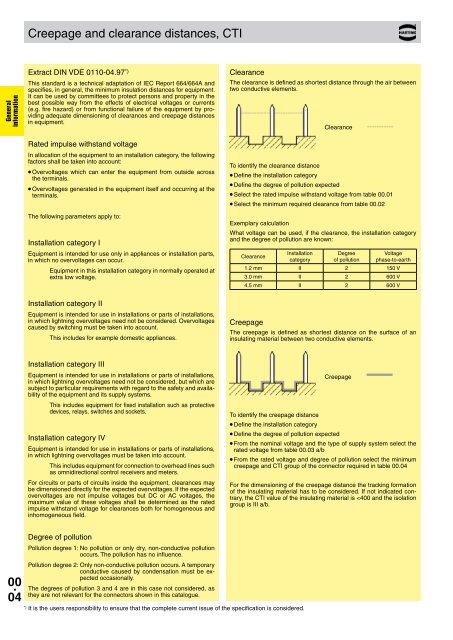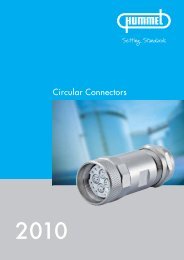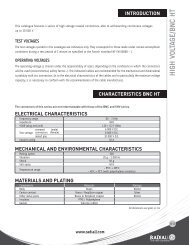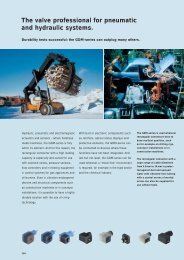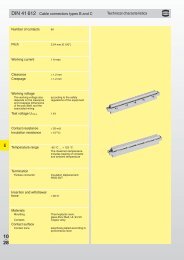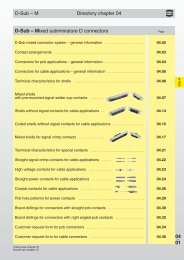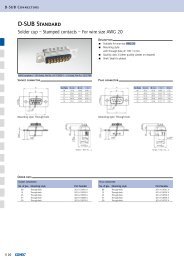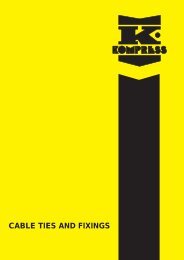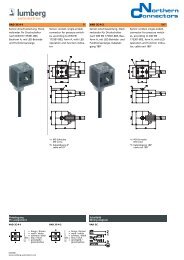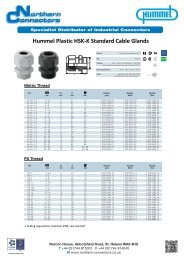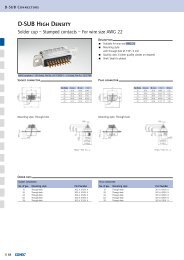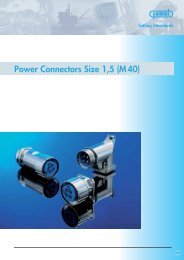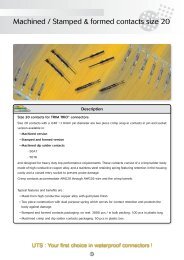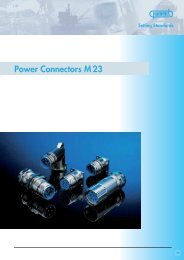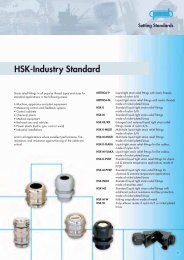HARTING - Northern Connectors
HARTING - Northern Connectors
HARTING - Northern Connectors
You also want an ePaper? Increase the reach of your titles
YUMPU automatically turns print PDFs into web optimized ePapers that Google loves.
Creepage and clearance distances, CTI<br />
General<br />
information<br />
Extract DIN VDE 0110-04.97 *)<br />
This standard is a technical adaptation of IEC Report 664/664A and<br />
specifies, in general, the minimum insulation distances for equipment.<br />
It can be used by committees to protect persons and property in the<br />
best possible way from the effects of electrical voltages or currents<br />
(e.g. fire hazard) or from functional failure of the equipment by providing<br />
adequate dimensioning of clearances and creepage distances<br />
in equipment.<br />
Clearance<br />
The clearance is defined as shortest distance through the air between<br />
two conductive elements.<br />
Clearance<br />
Rated impulse withstand voltage<br />
In allocation of the equipment to an installation category, the following<br />
factors shall be taken into account:<br />
● Overvoltages which can enter the equipment from outside across<br />
the terminals.<br />
● Overvoltages generated in the equipment itself and occurring at the<br />
terminals.<br />
The following parameters apply to:<br />
Installation category I<br />
Equipment is intended for use only in appliances or installation parts,<br />
in which no overvoltages can occur.<br />
Equipment in this installation category in normally operated at<br />
extra low voltage.<br />
To identify the clearance distance<br />
● Define the installation category<br />
● Define the degree of pollution expected<br />
● Select the rated impulse withstand voltage from table 00.01<br />
● Select the minimum required clearance from table 00.02<br />
Exemplary calculation<br />
What voltage can be used, if the clearance, the installation category<br />
and the degree of pollution are known:<br />
Clearance<br />
Installation<br />
category<br />
Degree<br />
of pollution<br />
Voltage<br />
phase-to-earth<br />
1.2 mm II 2 150 V<br />
3.0 mm II 2 600 V<br />
4.5 mm II 2 600 V<br />
Installation category II<br />
Equipment is intended for use in installations or parts of installations,<br />
in which lightning overvoltages need not be considered. Overvoltages<br />
caused by switching must be taken into account.<br />
This includes for example domestic appliances.<br />
Creepage<br />
The creepage is defined as shortest distance on the surface of an<br />
insulating material between two conductive elements.<br />
Installation category III<br />
Equipment is intended for use in installations or parts of installations,<br />
in which lightning overvoltages need not be considered, but which are<br />
subject to particular requirements with regard to the safety and availability<br />
of the equipment and its supply systems.<br />
This includes equipment for fixed installation such as protective<br />
devices, relays, switches and sockets.<br />
Installation category IV<br />
Equipment is intended for use in installations or parts of installations,<br />
in which lightning overvoltages must be taken into account.<br />
This includes equipment for connection to overhead lines such<br />
as omnidirectional control receivers and meters.<br />
For circuits or parts of circuits inside the equipment, clearances may<br />
be dimensioned directly for the expected overvoltages. If the expected<br />
overvoltages are not impulse voltages but DC or AC voltages, the<br />
max imum value of these voltages shall be determined as the rated<br />
im pulse withstand voltage for clearances both for homogeneous and<br />
inhomogeneous field.<br />
To identify the creepage distance<br />
● Define the installation category<br />
Creepage<br />
● Define the degree of pollution expected<br />
● From the nominal voltage and the type of supply system select the<br />
rated voltage from table 00.03 a/b<br />
● From the rated voltage and degree of pollution select the minimum<br />
creepage and CTI group of the connector required in table 00.04<br />
For the dimensioning of the creepage distance the tracking formation<br />
of the insulating material has to be considered. If not indicated contrary,<br />
the CTI value of the insulating material is


